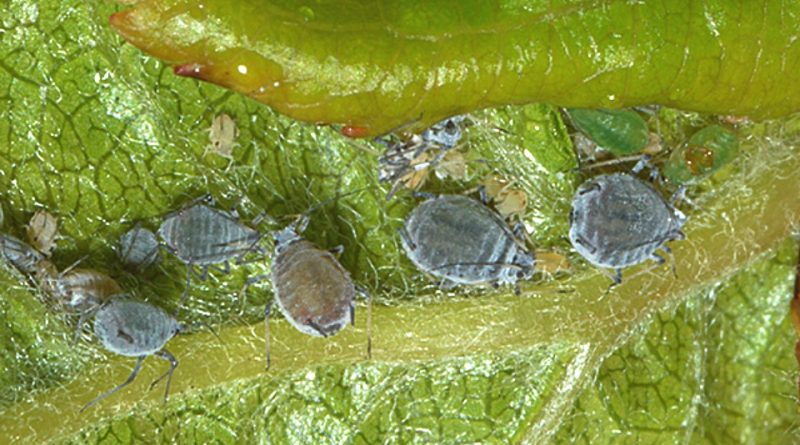Dysaphis pyri
Dysaphis pyri
The gray aphid of the pear tree (Dysaphis pyri (Boyer de Fonscolombe, 1841)) is a small homopterous Rincote belonging to the Aphididae family.
Systematic –
From the systematic point of view it belongs to the Eukaryota Domain, Kingdom Animalia, Eumetazoa Subarray, Bilateral Branch, Phylum Arthropoda, Subphylum Hexapoda, Insecta Class, Pterygota Subclass, Exopterygota Cohort, Subcoorte Neoptera, Paraneoptera Superorder, Rhynchotoidea Section, Rhynchota Order, Suborder Homoptera, Superfamily Aphidoidea, Family Aphididae and then to the Genus Dysaphis and to the Specie D. pyri.
Geographic Distribution and Habitat –
The Dysaphis pyri is a heterogony species, where the primary host plant is the Pero and the secondary host are the Gagli (Galium mollugo, G. aparine, G.sylvaticum). It lives and reproduces in the vegetational area of these two species, in temperate climates.
Morphology –
The gray Afide of the Pear is a very similar Afide and close, systematically, to the aphid of the Melo but, less dangerous as it rarely affects the fruits, it is recognized as the adults are small Aphids, long from 2.5 to 3 mm, globular in shape, greyish – dark lilac color, covered with a purplish white powdery secretion. The antennas are black-yellow at the end. The cornices are black, perpendicular to the body, longer than the tail that has a conical shape. The abdomen has a series of light spots on the first 5 segments. The winged have black antennae. These aphids live in colonies, on shoots or under the leaves.
Attitude and biological cycle –
The gray aphid of Pero is, as mentioned, a dioecious insect that carries out its cycle on the pear tree (primary host) and on spontaneous herbaceous plants. The founding generations appear at the end of the winter from which they originate 4-6 parthenogenetic generations. Subsequently they are transferred to the secondary guest and in autumn they return to the pear tree to lay their eggs.
The winter eggs are laid in the cracks of the scars of the petioles of the fruits. They hatch at the end of March; the young founders introduce themselves inside the buds that are about to open and the founders colonize the leaves. The winged appear from the third generation and reproduce on the Gagli. The migrants are visited by many ants who, by implementing a symbiotic action, protect them from predators such as the Coccinelle, the Sirfidi and from different Hymenoptera. Winged sessupari appear at the beginning of September and return to the peach tree.
Ecological role –
Following the presence of the gray Pea anphid, chlorotic curls of the leaves and deformation of the shoots appear, often accompanied by burns and necrosis due to the production of honeydew.
The attached leaves shrivel a lot and crosswise, assuming a yellowish green color; the honeydew causes on the leaves of the burns, moreover on this sugary substance the fumaggini (mushrooms) increase that further slow down the growth also for the diminished photosynthetic activity. In addition, the leaf curling favors the installation of the common Psilla del Pero (Cacopsylla pyri).
For the containment of the populations of this aphid, it is necessary to first follow the criteria of agroecology which must be prepared during the planning of the pereto. The construction of specialized plants, too narrow, without the presence of hedges and plant species that host the antagonists of this aphid are all factors that can then make it difficult to contain the insect. To these it is often added the fertilization with nitric fertilizers and the lack of grassing that favor this aphid to the detriment of its predators.
The fight against the gray Afide of Pero must therefore follow the criteria and methodologies of guided and integrated struggle; it must be carried out only if, at a careful sampling, the presence of the Aphid is ascertained on 5% of the controlled vegetation (5% of affected plants). Only in truly proven cases should a treatment be carried out with specific aficidi products, taking care to evaluate the presence of useful pollutants and insects that would be damaged by these interventions and favoring in the long term the biocenosis of this insect.
Guido Bissanti
Sources
– Wikipedia, the free encyclopedia.
– Russo G., 1976. Agricultural Entomology. Special Part. Liguori Editore, Naples.
– Tremblay E., 1997. Applied entomology. Liguori Editore, Naples.

